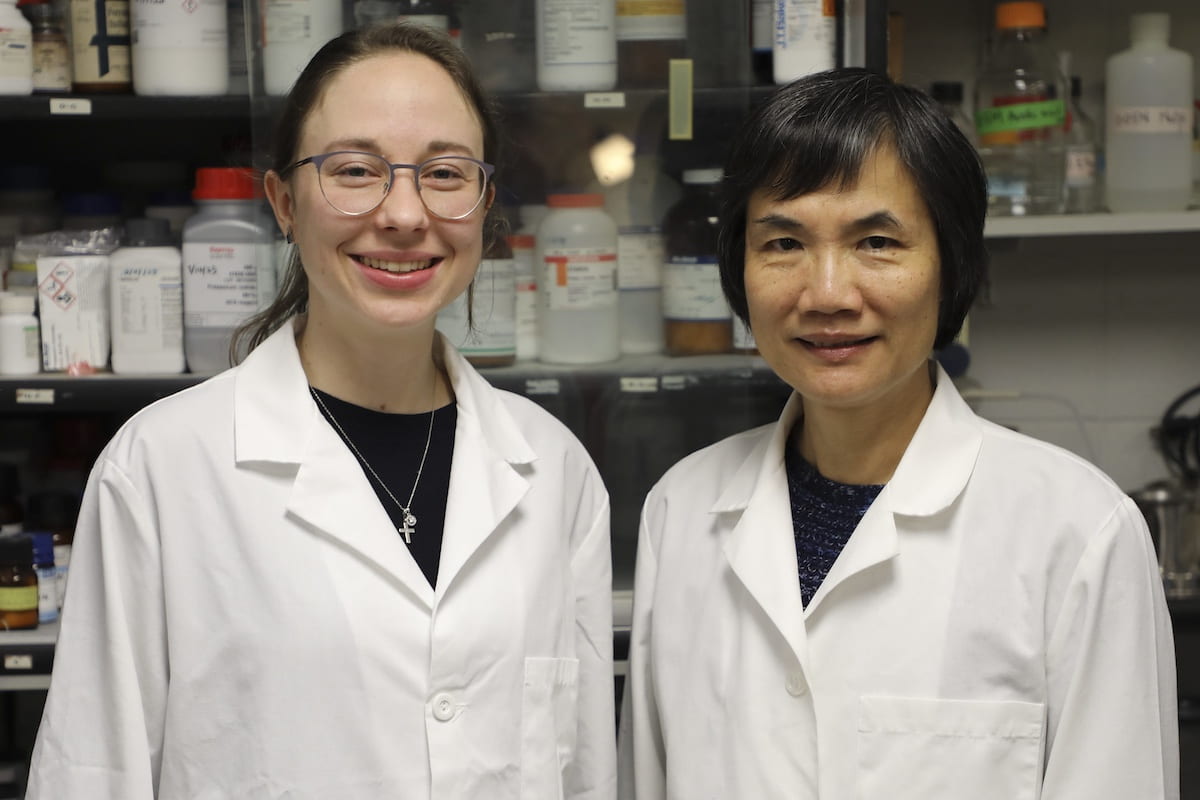Researchers Look to Rice for ‘Clean Label’ Ingredients
Modified starch is a common ingredient, helps with viscosity and texture
By Brittaney Mann – Mar. 28, 2024

MEDIA CONTACT
Nick Kordsmeier
U of A System Division of Agriculture
Arkansas Agricultural Experiment Station
(479) 575-6368 | nkordsme@uark.edu
Chemically modified starch is a common thickener in soups and other foods. Without modification, starch breaks down during high-temperature and high-shear food processing and no longer functions properly as a thickening agent.
As consumers express concerns over chemically modified ingredients, Wang is looking at alternatives. With the help of a $400,000 U.S. Department of Agriculture National Institute of Food and Agriculture grant awarded in 2023, Wang is exploring how to use polyphenols and proteins naturally present in pigmented waxy rice as a natural starch strengthener.
Polyphenols are a micronutrient that naturally occur in plants. She used pigmented waxy rice because the presence of polyphenols in the rice and the polyphenol-protein interaction that arises. “Waxy” rice is also known as “sticky” or “sweet” rice due to its low level of amylose, one of the ingredients that make up starch. Higher levels of amylose cause the rice to separate and become fluffy, whereas lower levels of amylose produce higher viscosities. Polyphenol-protein interactions naturally present in the pigmented rice aid in retaining a food’s viscosity, or thickness, during the cooking process.
Wang conducts research for the Arkansas Agricultural Experiment Station, the research arm of the University of Arkansas System Division of Agriculture. Her collaborators on the research include Annegret Jannasch, a doctoral student in the Dale Bumpers College of Agricultural, Food and Life Sciences, who works under the direction of Wang; Anna McClung, a recently retired research geneticist at the Dale Bumpers National Rice Research Center; Sun-Ok Lee, associate professor of nutrition for the experiment station; post-doctoral researcher Zeina Alraawi; and Suresh Thallapuranam, Cooper Chair of Bioinformatics Research and professor of biochemistry.
Wang, Jannasch and Lee work in the food science department in the Bumpers College. Thallapuranam is joining the team from the chemistry and biochemistry department in the Fulbright College of Arts and Sciences.
McClung provides the researchers with pigmented waxy rice samples.
“We propose that pigmented waxy rice can function like chemically modified starches but without the use of chemicals, so it will be a clean label ingredient,” Wang said.
“Clean label” is not a scientific term, but the food industry, academics and consumers define the phenomenon as choosing foods with easy-to-recognize ingredients and no artificial ingredients or synthetic chemicals, according to the Institute of Food Technologists.
Consumer perception
In recent years, consumers have raised concerns about ingredients used in food production, Wang noted. Some consumers aim to consume only minimally processed food.
The idea of minimal processing varies from person to person, Wang said. Some consumers prefer wheat flour, but others might consider wheat flour too processed and consume whole wheat flour instead.
“A lot of processed food is really for preservation or convenience,” Wang said. Food products such as ham, pickles and TV dinners, for example, are processed to help simplify food preparation for the consumer and to extend shelf life.
Wang’s research may alleviate these concerns related to modified starch.
Many foods contain modified starch, which is chemically altered to improve processing and storage stability, Wang said. Starches function as thickening agents to improve the texture and consistency of food products.
The inspiration for this project came from Wang’s recent research that explored the possibility of utilizing the interactions among polyphenols, protein and starch in pigmented waxy rice to increase satiation, the feeling of fullness. In that original project, Wang found that the pigmented waxy rice’s unique interactions between polyphenols and proteins allow starch to swell more in an acidic condition that simulates gastric environments.
“Starch, when it swells, is like a balloon — it becomes bigger and bigger,” Wang said. During food processing, “the temperature, the shear, the high acidity will completely break down the balloon. You want the balloon to swell more — that is how you create the viscosity — but you don’t want it to swell too much. The polyphenol-protein interactions help to maintain the starch structure so it will stay at that stage.
“That is why you can use starch to thicken any soup because the starch can swell more than 10 times its volume, but once it gets to that stage, it becomes very fragile,” she said.
Outside of consumer perception, Wang said that applying this pigmented waxy rice, as opposed to using modified starch, could provide additional environmental and health benefits.
With any chemical modification comes a residue, Wang said, so using a naturally occurring starch with these properties eliminates that concern. Polyphenols are present in many berries and vegetables, and a high amount of polyphenols are known to have anti-oxidant, anti-inflammatory and antidiabetic properties.
MEDIA CONTACT
Nick Kordsmeier
U of A System Division of Agriculture
Arkansas Agricultural Experiment Station
(479) 575-6368 | nkordsme@uark.edu
The research will take place in three phases. Wang and her team have finished the first phase, which evaluated pigmented waxy rice samples and their contents and compositions of proteins, starch and polyphenols. A research article titled “Elucidating the effect of polyphenol-protein interactions on rheological properties of purple waxy rice” was published in the Journal of Cereal Science this month.
The next phase will determine the nature of the polyphenol-protein interactions in pigmented waxy rice. Interactions between polyphenols and proteins involve chemical bonds linking two molecules, and it is important because a strong bond helps maintain granule integrity under high shear, temperature and acidic conditions, Wang said.
Finally, the researchers will apply thermal processing conditions to alter the extent of polyphenol-protein interactions so the resulting products will produce a wide range of viscosities for different applications.
“We really want to see the possibility of commercializing the resulting technology,” Wang said. “We want to see if any companies are interested and work with them.”
Companies using this to make cereals, pudding, or pasta is something that Wang hopes to see.
Wang will share an update on this research at the USDA-NIFA project director meeting in Amherst, Massachusetts, on June 17-18.
To learn more about Division of Agriculture research, visit the Arkansas Agricultural Experiment Station website: https://aaes.uada.edu. Follow us on 𝕏 at @ArkAgResearch and Instagram at @ArkAgResearch.
To learn about Extension Programs in Arkansas, contact your local Cooperative Extension Service agent or visit https://uaex.uada.edu/. Follow us on 𝕏 at @AR_Extension.
To learn more about the Division of Agriculture, visit https://uada.edu/. Follow us on 𝕏 at @AgInArk.
About the Division of Agriculture
The University of Arkansas System Division of Agriculture’s mission is to strengthen agriculture, communities, and families by connecting trusted research to the adoption of best practices. Through the Agricultural Experiment Station and the Cooperative Extension Service, the Division of Agriculture conducts research and extension work within the nation’s historic land grant education system.
The Division of Agriculture is one of 20 entities within the University of Arkansas System. It has offices in all 75 counties in Arkansas and faculty on five system campuses.
The University of Arkansas System Division of Agriculture offers all its Extension and Research programs and services without regard to race, color, sex, gender identity, sexual orientation, national origin, religion, age, disability, marital or veteran status, genetic information, or any other legally protected status, and is an Affirmative Action/Equal Opportunity Employer.




